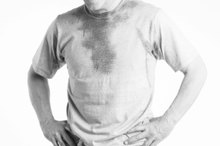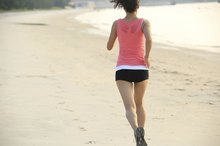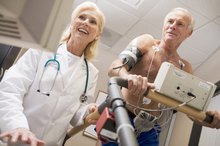Trouble Breathing While Exercising
Trouble breathing while exercising may manifest as shortness of breath, wheezing, a barking type of cough or tightness of the throat. There are many reason why you might develop trouble breathing during exercise including having recently begun an exercise program, exercise-induced asthma or a hiatal hernia. You need to know when trouble breathing during exercise is something that requires immediate medical attention and when it does not.
Age
Age, lifestyle, general health and general physical condition all factor into situations where you may experience breathing difficulties while exercising. After age 30, the rate of air flow through the lungs begins to slowly decline, making it easier for you to become short of breath during physical exertion. The muscles of the diaphragm and those between the ribs become weaker through the lifespan, requiring them to work harder to provide maximum air flow. These natural changes with aging don't prevent you from exchanging enough air because in youth, there is "excess" lung capacity that you body draws on as you age.
- Age, lifestyle, general health and general physical condition all factor into situations where you may experience breathing difficulties while exercising.
- After age 30, the rate of air flow through the lungs begins to slowly decline, making it easier for you to become short of breath during physical exertion.
Lifestyle and Physical Condition
What May Cause Shortness of Breath When Walking or Biking?
Learn More
If you've been maintaining a fairly sedentary lifestyle and are beginning an exercise routine or program, you may find yourself short of breath during your initial workouts. The same applies if you are changing your workout to include more aerobic activity; you may experience mild shortness of breath until your body begins to acclimate to the change in physical activity. If you are overweight or obese, exercise may result in mild shortness of breath.
Health
Your overall health is another important consideration for why you may experience trouble breathing while exercising and the reason why it is important to consult your health care provider before beginning any exercise program. Heart disease, respiratory disease and hypertension may warrant that you begin with short sessions more frequently rather than one long daily session until your body builds up tolerance to the new physical activity. Exercise-induced asthma is a condition that can be treated with the use of medication, allowing you to exercise without experiencing wheezing and gasping.
Considerations
What is DOE in Medical Terms?
Learn More
Shortness of breath due to age, lifestyle and physical condition is not unusual if that is the only symptom present. Symptoms such as chest pressure, pain or discomfort, wheezing in the absence of known diagnosis of asthma, breathing trouble that is severe or worsens with time, presence of a barking cough and tightness in the throat are all signals the need to be seen by a health care professional. If difficulty breathing occurs suddenly or you seem not to be getting enough air with your breaths, contact emergency services.
Related Articles
References
- MedlinePlus: Breathing Difficulty
- MedlinePlus: Aging Changes in the Lungs
- Wahls SA. Causes and evaluation of chronic dyspnea. Am Fam Physician. 2012;86(2):173-82.
- John Hopkins University. Heart & Vascular Institute. Shortness of breath. Updated 2019.
- Whited L, Graham DD. Abnormal respirations. [Updated 2019 Jul 30]. In: StatPearls [Internet]. Treasure Island (FL): StatPearls Publishing; 2019.
- Chourpiliadis C, Bhardwaj A. Physiology, respiratory rate. [Updated 2019 Jan 28]. In: StatPearls [Internet]. Treasure Island (FL): StatPearls Publishing; 2019.
- Abidov A, Rozanski A, Hachamovitch R, et al. Prognostic significance of dyspnea in patients referred for cardiac stress testing. N Engl J Med. 2005;353(18):1889-98. doi:10.1056/NEJMoa042741
- Cleveland Clinic. Emphysema: Diagnosis and tests. Updated August 9, 2019.
- Munari AB, Gulart AA, Dos santos K, Venâncio RS, Karloh M, Mayer AF. Modified Medical Research Council dyspnea scale in GOLD Classification better reflects physical activities of daily living. Respir Care. 2018;63(1):77-85. doi:10.4187/respcare.05636
- Guly HR. ABCDEs. Emerg Med J. 2003;20(4):358. doi:10.1136/emj.20.4.358
- Kasper DL, Fauci AS, Hauser SL. Harrison's Principles of Internal Medicine. New York: Mc Graw Hill education, 2015.
- MedlinePlus. Breathing difficulty. Updated 03/05/18.
- Nishino T. Dyspnoea: underlying mechanisms and treatment. British Journal of Anaesthesia. 2011;106(4):463-74. doi:10.1093/bja/aer040
Writer Bio
Lee Woodard is a freelance writer/editor with more than 15 years experience in the field of writing and a background in nursing spanning three decades. In addition to graduating from nursing school, Woodard attended Bowling Green State University with an emphasis in liberal studies. He has been published on various websites and successfully ghostwritten multiple books.









